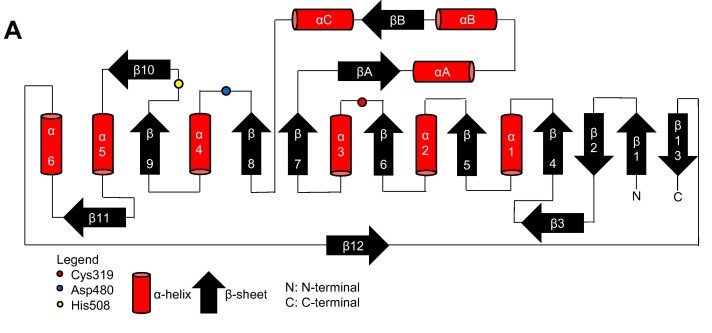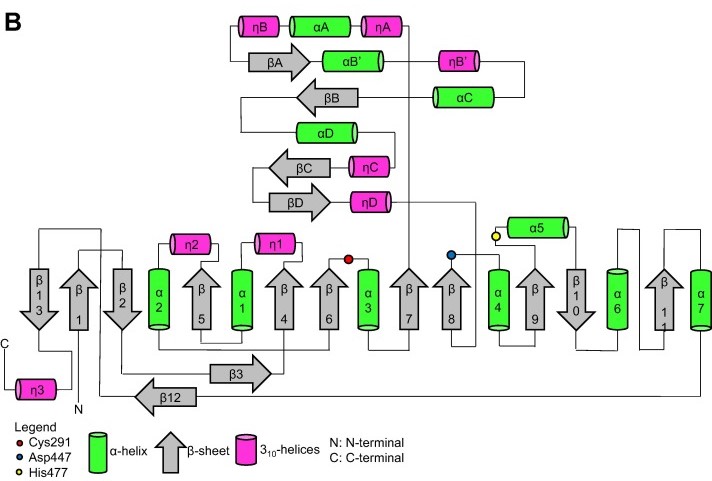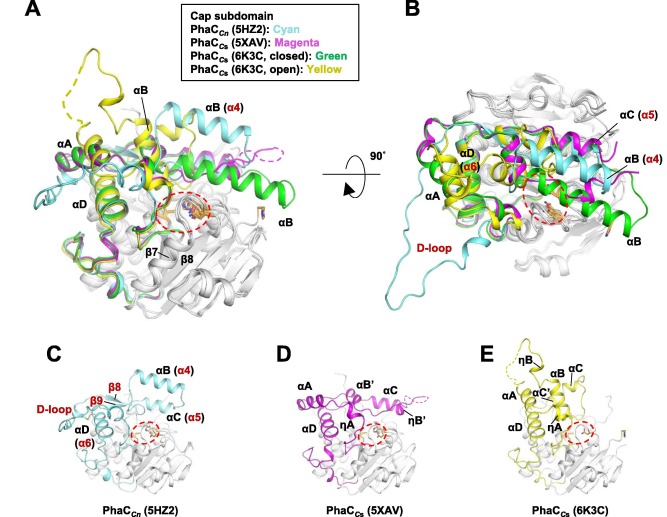User:Maria Júlia Pasian Ferreira/Sandbox 2
From Proteopedia
Maria Júlia Pasian Ferreira (Talk | contribs)
(New page: ==Introduction== <StructureSection load='1stp' size='340' side='right' caption='Caption for this structure' scene=''> Poli 3-hydroxyalcanoates (PHA) are the main components of the cytoplas...)
Next diff →
Revision as of 23:15, 1 June 2024
proteopedia linkproteopedia linkIntroduction
Poli 3-hydroxyalcanoates (PHA) are the main components of the cytoplasmatic inclusions, called PHA granules. They serve as carbon and energy reserves in many species of procariotes. PHA polymers can be made from different sized monomers, ranging from 4 to 14 carbon atoms. They are typically synthetized when there is an unbalanced distribution of nutrients in the medium, mainly an abundance of carbon sources coupled with the lack of another essential component. Among the existing PHAs, the most common are the poli-3-hydroxybutirate (PHB) polymers. (Barbosa, Gomez, Torres, 2018, p. 52). PHBs are specially relevant due to their properties that resemble conventional plastics, such as polypropylene. Since they are biopolymers made from renewable, biodegrabable and compatible source materials, PHBs present themselves as an industrial alternative to petrol-based plastics. (Byrom, 1987; Madison and Huisman 1999). The polymerization of PHA monomers is performed by the PHA sintase/polymerase (phaC) enzyme. At first, two acetyl-CoA molecules are condensed into one acetoacetyl-CoA by a β-ketoacyl-CoA thiolase, and then reduced to (R)-3-hydroxybutyryl-CoA by the acetoacetyl-CoA dehydrogenase. Finally, phaC polymerizes the (R)-3-hydroxybutyryl-CoA molecules into the PHA polymer. (Reddy et al., 2003). Currently, there are four known classes of phaC, that are distinguished by their primary structure, substrate specificity and subunits composition (Rhem, 2008; Neoh et al., 2022). Despite vast diversity, only the catalytic domain of the PhaCcn-CAT from Ralstonia eutropha H16 and the USM2 PhaCcs-CAT from the Chromobacterium sp., both being class 1 phaCs. (Neoh et al., 2022).
more stuffThis is a default text for your page Gustavo Sartorelli de Carvalho Rego/Sandbox 1. Click above on edit this page to modify. Be careful with the < and > signs. You may include any references to papers as in: the use of JSmol in Proteopedia [1] or to the article describing Jmol [2] to the rescue. Class 1OverviewThe class 1 phaCs synthetize preferentially short chain PHAs, with 3 to 5 carbon monomers, and are composed by a single enzymatic unit, with molecular mass ranging from 63 to 73 kDA. (Chek et al., 2018; Neoh et al., 2022). Thanks to the X-ray cristallography data from PhaCcn-CAT and PhaCcs-CAT, it was possible to categorize the class 1 phaCs in based on their molecular organization, made of two domains: The N-terminal domain and the catalytic C-terminal domain. The C-terminal domain carries the catalytic site, formed by the aminoacid triad (Cys-Asp-His) located deep within the hydrophobic cavity, that in the closed conformation is partially covered by the Cap subdomain.(Chek et al., 2018; Neoh et al., 2022). N-terminal domainThe N-terminal domain has no defined function, and attempts to perform X-ray cristallography of this region have not been sucessful. Many studies have gathered evidence of possible roles that the N-terminal domain performs, such as: enzymatic activity efficiency, binding to PHA granules, substrate specificity, phaC expression, interaction with other PHA-related proteins and dimers formation and estabilization. Still, elucidation of its exact catalytic mechanism remains necessary.(Neoh et al., 2022). C-terminal domainContrary to the flexible N-terminal domain, the C-terminal domain is relatively stable, making its crytalization process easier. Because of this, it was possible to obtain the C-terminal domain structure from PhaCcn-CAT and PhaCcs-CAT through X-ray cristallography, with resolution of 1.8 Å and 1.48 Å, respectively. The C-terminal domain has the catalytic site, with the aminoacid triad (Cys-Asp-His), the substrate entrance and the product egress tunnel. The overall form of a phaC protein is that of a typical protein from the α/β-hydrolase-fold, with the C-terminal domain made of an α/β-hydrolase core subdomain and a Cap subdomain, corresponding to the Thr347-Pro471 residues in PhaCcn, and Thr319-Pro438 residues in PhaCcs. It is in the α/β-hydrolase subdomain that the entrance tunnel, the catalytic site and the product egress tunnel are located. This region seems to be preserved in phaCs. Regarding the Cap subdomain, the LID region is extremely dynamic and flexible, having an open or closed conformation based on structural changes. Because of this, the Cap subdomain, specially the LID region, is not as conserverd in the phaCs as the α/β-hydrolase subdomain. The Cap subdomain is located after the β7 sheet, and connects with the β8 sheet from the α/β-hydrolase core. In PhaCcn, the Cap subdomain is formed by three α-helixes (α4, α5 and α6) and two β-sheets (β8 and β9). Meanwhile, PhaCcs has six α-helixes (αA, αB, αC, αD, ηA and ηB'). The cristallography of PhaCcs-CAT bound to its substrate revealed the complex assymetric dimer structure of this enzyme. The phaC dimer form can be induced by the presence the substrate. Due to the dynamic and flexible properties, specially of the LID region, the Cap subdomain is paramount in the phaC dimer formation and regulation of substrate entry and product release, since it determines the protomer's movements, regulating the change between the closed form - homodimer- and the open form - heterodimer. (Neoh et al., 2022). Secondary structureTopology diagram for the catalytic domain of the PhaCcn-CAT monomer. (Neoh et al., 2022).
Topology diagram for the catalytic domain of the PhaCcs-CAT monomer. (Neoh et al., 2022).
Quaternary structureQuaternary structure of PhaCcn-CAT and PhaCcs-CAT, with the Cap subdomain highlighted. (Neoh et al., 2022).
Class 2Among the 4 classes of phaC, the class 2 enzymes are the only that synthetize preferentially medium chain PHA, with 6 to 14 carbon monomers. Just like the class 1, they are also formed by a single enzymatic subunit, however, its molecular mass is, in general, higher than class 1 phaC, with approximately 62 kDa. It is suggested that the class 2 molecules also have two domains. (Chek et al., 2018). Class 3The class 3 phaC produce preferentially short chain PHAs, with 3 to 5 carbon monomers. However, differently from classes 1 and 2, they recquire an additional subunit, the phaE, and has a smaller molecular mass ranging from 40 to 53 kDa. (Chek et al., 2018; Jia et al., 2016). Class 4Just like class 3, the class 4 is also composed by two enzymatic units, phaC (catalytic subunit) and phaR, and has a smaller molecular mass than the other classes. The class 4 phaC also produce preferentially short chain PHAs, with 3 to 5 carbon monomers.
stuffThis is a sample scene created with SAT to by Group, and another to make of the protein. You can make your own scenes on SAT starting from scratch or loading and editing one of these sample scenes.
| ||||||||||||
References
- ↑ Hanson, R. M., Prilusky, J., Renjian, Z., Nakane, T. and Sussman, J. L. (2013), JSmol and the Next-Generation Web-Based Representation of 3D Molecular Structure as Applied to Proteopedia. Isr. J. Chem., 53:207-216. doi:http://dx.doi.org/10.1002/ijch.201300024
- ↑ Herraez A. Biomolecules in the computer: Jmol to the rescue. Biochem Mol Biol Educ. 2006 Jul;34(4):255-61. doi: 10.1002/bmb.2006.494034042644. PMID:21638687 doi:10.1002/bmb.2006.494034042644



